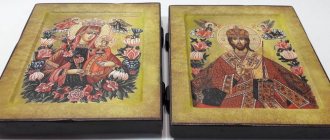Can good looks be considered a sin? A person does not choose how to be born.
It seems to me that this approach to the issue of beauty is very narrow. Why is it only supposed to talk about female beauty? Beauty Day concerns beauty in general - art, culture, aesthetics. I would like to focus on the inner component of beauty. An artist is not only someone who knows how to paint pictures or do something else creatively, but also someone who knows how to notice the beautiful in the world around them: flowers, clouds, trees. Let us remember how Saint John of Kronstadt kissed flowers with the words: “I kiss the hand that created you.” Everything in the world is so complex and beautifully created that it is impossible not to admire the Creator’s plan.
If we narrow the topic and talk about female beauty, what can we say? Woman is the crown of creation, since she was created last. The substance from which Adam was taken is rough: it is earth, clay. A woman is created from a completely different material - from a rib, that is, from a living creation. This means that a woman is the most beautiful and most perfect creature on earth.
Beauty and a sense of beauty are inherent in man by nature. We can look at the world around us and through it know our Creator and Maker. It is natural to enjoy female beauty. It’s like with food: God wanted us to enjoy eating it. What sin is this? Everything is from God, and beauty too. It is He who creates all these plexuses of chromosomes, the individuality of each person. Beauty is natural for the world created by God; it is no coincidence that Fyodor Mikhailovich said that it would save the world.
Of course, everyone has their own perception of beauty. Some people like dyed hair, bright makeup, false eyelashes, super manicure. Such a girl goes and thinks that she looks the best. But a person brought up differently does not perceive it. It’s like with music: someone who has been listening to the classics since childhood cannot take modern “untsa-untsa” seriously. There are people who love a chaste appearance. In this regard, I remember the famous boxer Mohammed Ali. One day he saw his daughter in open clothes and said that female beauty should be hidden from prying eyes, just as everything expensive is hidden in nature: gold, pearls, diamonds.
It seems to me that now there is a degradation in the perception of beauty, some kind of vulgarization. Girls are told that it is fashionable to be a bitch; from TV and computer screens there is a wave of some kind of aggressive feminism, which in general undermines not only the psyche of women, but the foundations of the family. Humanity and its entire history rest on the family. That’s why it’s so important what we consider beautiful: if what is vulgar and vulgar is considered beautiful, then these qualities will be valued in women. What will happen if women with such qualities are chosen as wives? If a girl grew up in a chaste family, where she was raised by both her father and mother, then, most likely, everything will be fine in her life - the example of the mother and the authority of the father, even without words, do their job and put the child on the right track. A guy looking for a girl to start a family, and not for sexual experience, will look for a person with the appropriate appearance, behavior, and internal structure. This is also a matter of education.
At the crossroads of cultures
Appearance is, in many ways, a socially determined phenomenon and a way of self-identification. For Christians of the first centuries, the issue of cultural self-identification was quite acute. Having spread to the territory of the Roman Empire and beyond, Christianity carried within itself both elements of Jewish and Greco-Roman culture.
The apostles had a difficult time: it was not enough to preach Christ - they had to offer people real “recommendations” for Christian life, so that the gospel ideals would take root in any national culture.
After all, according to the words of the Apostle Paul, a Christian is a “new man” who “is renewed in knowledge according to the image of Him who created him, where there is neither Greek nor Jew, circumcision nor uncircumcision, barbarian, Scythian, slave, free, but all Christ is in everything."
The Apostle in his epistles gives instructions regarding the appearance of Christian women: “so that wives, too, in decent attire, with modesty and chastity, adorn themselves not with braided hair, not with gold, not with pearls, not with costly clothing, but with good deeds.”
Note that we are not talking about a prohibition here: the apostle only says that the external is not the main thing, and you should not spend too much effort and money on it, which was probably characteristic of Greco-Roman culture. After all, Christ, unlike the pagan gods, does not need gold - He needs the love of a person and the conversion of his soul.
The tendency specifically to condemn “beautification” and self-care has to some extent intensified thanks to the development of monasticism and the emergence of patristic literature, which, in fact, has become the main (after Scripture) “guide to action” not only for monks. Over time, the desire for maximum asceticism and “mortification of the flesh” began to seem to many not just a virtue, but the very essence of Christianity.
The main thing is relevance
From the baptism of Rus' until the events of 1917, Christianity was actually the state religion in Russia, but, nevertheless, Russian women, regardless of class, decorated themselves, used “rubbing” and cosmetics, and dressed up – including for church.
The fact is that Christianity has always treated appearance based on two main criteria: ethical and aesthetic. Ethical criteria were determined by the basic standards of the Gospel, the main one of which is not to lead into temptation.
Moreover, temptation is understood in a broad sense - not only a sexually revealing outfit can shock and cause indignation. Excessive and inappropriate luxury or equally inappropriate sloppiness in the image is also a serious reason for temptation. Therefore, the main principles of Christian ethics regarding appearance are appropriateness and a sense of proportion.
The aesthetic criterion is determined by the concepts of beauty that exist in the culture of a particular Christian people, a particular class, etc.
What does the Bible say about makeup?
There are several passages in Scripture about beauty rituals and makeup. When Esther entered the palace, she underwent a year-long beauty ritual for purification. After she had completed her twelve months' preparation, it was each young woman's turn to go to King Artaxerxes, for thus the days of their preparation were allocated.
This passage reads: “Before it was the young woman’s turn to appear before King Xerxes, she had to undergo twelve months of the cosmetic procedures prescribed for women, six months with myrrh oil and six with perfumes and cosmetics.”
Planets with hidden oceans beneath their crust could be habitable
St. Petersburg and other regions with the largest increase in crime in 2020
The craftswoman showed what beauty she makes from egg trays: there’s no shame in giving as a gift
There are several poems about makeup or cosmetics. The passages are warnings and words of wisdom that remind us that God is not concerned with our appearance, but with what is in our hearts.
We should remember Proverbs 31:20: “Charm is deceiving, and beauty is fleeting; but a woman who fears the Lord is worthy of praise.”
The passages we find (1 Timothy 2:9-10, Jeremiah 4:30, 1 Peter 3:3-4) have one common thread. We discover that God is not against women looking beautiful. But God is against women looking seductive and secular.
How to dress for church?!
The whole family went to church, and one friend gave instructions on how to dress for church, both men and women. I discovered a lot for myself, but when I got home I decided to dig deeper and this is what I found.
The Orthodox Church has many traditions and rules that must be followed. But sometimes a lack of information baffles us. What to wear to church? Can a woman wear trousers? And is it necessary to cover your head? Are there any special rules for men and children?
There was a time when people wore their best clothes to Sunday church services; they were even called “Sunday clothes.” Now there is no such tradition. On the contrary, nowadays people often dress too casually for church. But no one has canceled the rules and traditions.
You need to wear your best to church. Clothing should be modest, but this modesty should not be ostentatious, so as not to attract attention. Here are some guidelines for dressing in church:
Children: Only young children (under 10) are allowed to wear shorts to church - and only the classic version. Gym shorts, cut-off pants, or stretch shorts are inappropriate clothing for church (whether for children or adults). Shoes or sandals must be clean. You cannot wear T-shirts with any slogans. The child, if it is a boy, should be dressed in classic trousers or shorts and a shirt or, in extreme cases, a plain T-shirt. The girl should be dressed in a dress of soft colors.
Women: Dress should be modest. No tank tops or dresses with spaghetti straps, no miniskirts or tight outfits. No dresses with cutouts at the back. Shorts of any style are prohibited. If a woman wants to wear trousers to church, they should be trousers, not jeans or leggings. Although in some churches you can still hear reproaches for wearing trousers. So just watch what the people in your church are wearing.
As for cosmetics, makeup should not be bright and provocative. You can lightly tint your eyelashes. But under no circumstances should you use lipstick. Have you ever seen an icon covered in lipstick? If you cannot do without it, wipe your lips before entering the temple. There is also an ancient tradition of covering your head with a scarf when entering a temple. There is debate about its origin and relevance, but tradition is tradition. The more modest you look, the less reason you will have to worry. The main thing is not to overdo it. A dark skirt that reaches to the toes looks demonstrably modest, which is also not good.
Men: Men should also dress modestly. While a jacket and tie are optional, the shirt must have a collar and be buttoned up (only the collar button can be left undone, but two or three undone buttons are not acceptable). Trousers must be clean and ironed. Jeans (any color) are too casual for church. Again, shorts are not allowed. And remember, you need to dress tastefully for church. Before entering the temple, a man must remove his headdress.
Also, before going to church, it is better for both women and men not to wear perfume. And finally, the most important rule of etiquette in church is not to attract unnecessary attention to yourself - neither with clothes, nor behavior, nor too strong a smell.
In general, my husband, for example, always wears jeans, sports pants in the summer, the child was dressed in shorts in the summer, in winter in warm pants (but not trousers), I wore a dress myself, it’s just above the knees. In general, how I found out all this, I told my husband, so now I’ll buy myself a lower skirt, my husband will wear trousers, and we’ll dress up my son! We will learn little by little, it’s a pity that in front of the entrance to the temple there is not, for example, a leaflet hanging about how to dress for church, and this is important in our time, the priest does not enlighten, and the grannies make a comment.
"Orthodox subculture"
A special “Orthodox dress code” that turns women into shapeless, sexless creatures is the product of the “Orthodox subculture” that formed in the post-Soviet twenties - the 90s and early 2000s.
The time when religion ceased to be illegal in Russia once again raised before Christians the difficult question of self-identification. And, unfortunately, the long separation from the living Christian tradition played a role: many began to try to build their lives according to mythological ideas about the piety of pre-revolutionary Russia and the “God-bearing people” as the “guardian of Orthodoxy” (hence the love for handkerchiefs - once a purely peasant element of attire) .
In Russia, “folk Orthodoxy” then became widespread, which became a national subculture, rather marginal, with a specific understanding of piety.
One of the significant features of this subculture was the sharp contrast between the “church” and the “secular.” In this case, “worldly” meant the whole culture. People seemed to “go into isolation”, building their lives exclusively on monastic literature, mythological ideas about the “ideals of Holy Rus'” and countless apocryphal brochures.
It was then that a rather tenacious stereotype was formed in this environment that since “the flesh is evil and sin,” then one must treat it accordingly. Taking care of oneself began to seem to many to be an almost fatal vice, and a secluded life in a “church context” seemed to be the only correct and “saving” form of existence.
Ignoring the “worldly” society has led to the fact that the need for an ethical and aesthetic assessment of one’s own appearance has lost its meaning. Instead of being “the light of the world,” according to the word of Christ, such “Orthodox” began to avoid and neglect this world, neglect themselves in this world.











